What diseases cause purulent exudate?
Pus released from the mammary gland is not only a symptom of the presence of inflammation in the breast tissue, but also of malignant formations.
Doctors note that this situation is typical not only for women’s breasts, but also for men’s. Typically, purulent fluid is formed as a result of serous or purulent inflammation of the mammary glands and is distinguished by specific features:
| Options | Peculiarities |
| Consistency | Viscous. Thick. |
| Color | Grey. Green. Brown. Transparent. Bloody. White. |
| Smell | Unpleasant. |
| Compound | Cholesterol. Albumin. Leukocytes. Fats. DNA particles. Enzymes. Products of microbial activity. Impurities of skin and muscle tissue. |
Doctors identify the following diseases for which the flow of purulent exudate from the nipples is a characteristic symptom:
| Causes | Features of the painful condition |
| Mastitis | It is diagnosed in nursing women due to the formation of cracks in the nipples, when the mother does not quite correctly attach the baby to the breast or does not completely express milk. With mastitis, the discharge of pus is accompanied by other unpleasant symptoms. |
| Nipple injury and infection | Damage and infection of the nipple can be caused by: - domestic trauma; - rough stimulation of the nipple; — piercing the nipple (piercing); - incorrect technique of expressing milk. All these situations are a favorable environment for the development of infection and the formation of purulent fluid. |
| Intraductal papillomas | New growths similar to warts form on the walls of the milk ducts. Papillomas negatively affect the walls of the milk canals, contributing to their deformation. One of the signs of the disease is the flow of pus from the nipples. |
| Neoplasms of benign and malignant origin | The development of a tumor in the milk ducts also deforms their walls. The flow of pus from neoplasms indicates their significant size. |
| Mastopathy | Usually, with mastopathy, the discharge is not purulent in nature. Pus indicates an advanced stage of the disease, irritation, deformation and damage to the walls of the milk canals by growing seals. |
| Purulent cyst | The main provoking factor is hormonal disorders. |
| Nipple fissures | When a baby is placed incorrectly on the breast, microcracks are formed, which are entry points for pathogens. The activity of bacteria provokes inflammation and accumulation of purulent secretion, which then leaks from the nipple. |
| Carrying out surgery on the gland | The appearance of purulent exudate from the nipples in the postoperative period is a sign of infection during surgery, both in women and men. |
| Carbuncles and boils | The formation of such abscesses on the nipples is a rare situation, but they still occur. Gradually accumulating, purulent fluid exits through the milk ducts if there are no other options for exit. Such abscesses are extremely painful and rise above the skin surface of the gland in the form of red bumps. |
Determining the color
Based on the color of the discharge, the doctor can easily determine the disease that is causing the disease:
- Yellow. Yellow discharge with a creamy tint (colostrum) is released after childbirth in the first days. If a yellowish tint appears before menstruation and is accompanied by pain, then mastopathy can be assumed.
- Purulent. They appear when an abscess develops inside the ducts, and are observed with mastitis. Bloody discharge is dangerous. They often indicate a malignant neoplasm.
- White. Appear after taking contraceptives and with a pituitary tumor.
- Green. The dark green color is given by the pus that is released during mastitis.
- Brown. Occurs when a cyst or tumor forms in the mammary gland. A dark-colored liquid is released when it enters the milk ducts when the capillaries are damaged.
- Transparent. If they appear before menstruation, this is normal.
- Bloody. This is a sign of the development of a malignant neoplasm or damage to blood vessels.
- Black. Observed during the disintegration of a malignant neoplasm.
The amount of fluid released may be small or quite large when it is necessary to use breast pads.
Signs of colostrum during pregnancy
Before the appearance of colostrum, you may experience discomfort in the breasts: itching and tingling. This is explained by the movement of secretions through the ducts. The breasts increase in size, become heavy and firm to the touch.
What month should I wait?
The production of colostrum begins to occur from the earliest stages of gestation. However, it can only be noticed at a later stage. In 20% of cases, pregnant women notice the appearance of fluid in the early stages of gestation.
The remaining 80% of women do not see or feel the appearance of a secretion until the 12th week. In the early stages, the amount of secretion is still too small and is not released from the nipples of the pregnant woman.
The second trimester (13-30 weeks of gestation) is marked by increased production of prototype breast milk. Most pregnant women notice the appearance of sticky liquid on their underwear. Colostrum may not be released every day in the second trimester. Doesn't depend on its appearance or time of day.
Late pregnancy (from 31 weeks until delivery) is characterized by abundant production of nutritious secretions. By this time, the color of the colostrum loses its saturation, and its quantity may remain virtually unchanged.
The moment when colostrum appears varies from person to person. It is impossible to say exactly when to expect it. Strengthening its production is influenced by:
- emotional shocks (positive or negative);
- hot shower or bath;
- high temperatures and high humidity in the room;
- hot drink;
- sexual contact;
- breast massage;
- genetic predisposition.
What color is the discharge from the nipples?
The acceptable color of the secretion is yellow or cream shades; the appearance of a translucent liquid is possible.
Typically, at the beginning of the production process, yellow or cream-colored colostrum is released. During gestation, its color changes and in later stages the secreted fluid may become transparent.
Does your chest hurt?
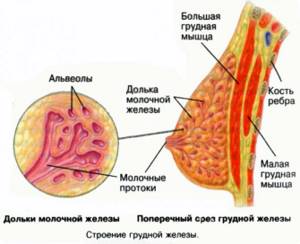
During the flow of colostrum, a woman may experience some discomfort in her breasts. It manifests itself with itching and tingling. This is normal, as the woman feels the fluid moving through the milk ducts.
If pain occurs in the chest area, especially associated with a feeling of heaviness in the lower back, you must inform your doctor. This way the body can signal the risk of miscarriage or premature birth.
The appearance of chest pain can signal the presence of inflammation in the body, which can trigger the occurrence of mastitis and congestion in the chest. In such conditions, breast milk poses a danger to the baby. To prevent such situations, you need to promptly inform your gynecologist about changes in your health.
Where does colostrum accumulate?
The main purpose of the female breast is to feed offspring. There are cavities inside it designed to store milk during lactation. When the concentration of prolactin in the body increases during pregnancy, the process of producing breast milk starts. At first, it is immature and is excreted in the form of colostrum. During pregnancy, its amount is small and it accumulates in the milk ducts. As the volume increases, colostrum begins to flow into the breast cavities and, when they are filled, spontaneously flows out through the nipples.
Breast self-examination
In order to “catch” the onset of a disease in time, it is useful to conduct periodic breast examinations yourself. It's easy and doesn't take much time.
The examination is carried out in the first half of the monthly cycle after the end of menstruation
- Once naked to the waist, you need to stand in front of the mirror. With your hands down, carefully examine your chest to see if there is any redness, swelling, or changes in the shape of the glands. Raise your hands behind your head and examine your chest in this position.
- Gently squeezing the nipples at the bases, check for any discharge.
- Holding one hand behind your head, use gentle circular movements to examine each gland from the nipples to the armpits. Repeat the examination in the supine position.
Normally, no hardness or swelling should be felt in the chest. Any oddities should alert you - discharge, inverted nipples, bulges, changes in skin color.
You need to examine your breasts yourself once every 3-4 months, this will allow you to notice any changes in a timely manner.
If you detect discharge from the mammary glands, be sure to consult a doctor immediately. There is no need to panic or be afraid. The vast majority of glandular discharges are not cancer. The term “cancerophobia” is even common among doctors, the fear of this disease is so strong among patients. Timely diagnosis and treatment will prevent the development of complications.
Prevention of breast diseases
For the purpose of prevention, every woman should be examined by a mammologist once a year. It is also recommended to regularly conduct preventive gynecological examinations and promptly treat diseases of the endocrine system.
Breast self-examination plays an important role, which should be performed once a month. It allows you to detect lumps and external changes in the condition of the mammary glands at an early stage.
It is necessary to avoid hypothermia and chest injuries, stress, and uncontrolled use of medications.
Video: How to do a breast self-examination
One of the most common symptoms of breast diseases is nipple discharge, which is observed in 7% of mammologist patients. In most cases, this symptom is caused by non-life-threatening conditions. Approximately 5% of women with this symptom are subsequently diagnosed with a malignant tumor of the gland. To find out what nipple discharge means, you need to see a doctor.
p, blockquote 1,0,0,0,0 –>
p, blockquote 2,0,0,0,0 –>
When should you see a doctor?
There are a number of symptoms, if they occur, you should immediately contact a specialist:
- discharge bothers you for more than two days;
- they contain an admixture of blood;
- the secretion comes out of only one mammary gland;
- the discharge has a thick consistency;
- peeling appears on the skin of the nipple;
- loss of symmetry (increase in size, formation of dense knots);
- the color of the nipple and the area around it changes;
- pain appears in the chest.
Discharge from the mammary glands when pressed, as well as any changes in this area should not be ignored. Timely visits to the doctor, diagnosis, and therapy will help avoid complications and serious illnesses.
Nipple discharge as normal
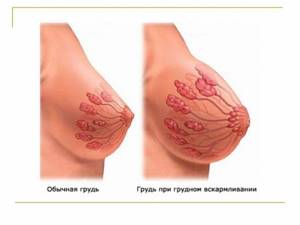
Breast discharge is normal if it is milk:
- in pregnant women - in a small volume, with pressure on the gland;
- nursing;
- for some time after the end of lactation (up to 2-3 years). Moreover, the duration of this period depends on the age of the woman and the number of pregnancies.
A certain amount of sterile fluid is constantly formed in the mammary gland, which must be excreted. A woman may notice small amounts of clear discharge from one or both breasts in the following cases:
- strong pressure on the chest;
- taking hormonal medications;
- treatment with antidepressants;
- wearing a tight bra;
- significant physical activity.
An opaque liquid will be released from the nipple after ductography - an X-ray examination with the introduction of contrast into the mammary gland.
Competent diagnostics
Pathological processes in the mammary gland are the sphere of influence of the mammologist. When contacting him, you will be assigned:
- mammography;
- microscopy and culture of breast discharge;
- ultrasonography;
- Magnetic resonance imaging;
- CT;
- clinical blood test;
- cytological examination;
- tests for the level of various hormones in the body;
- radiography;
- ductography;
- biopsy, etc.
These diagnostic methods allow you to examine the structure of the mammary gland, assess the degree of its functionality, identify the presence of an inflammatory or infectious process, and also eliminate the risk of developing a cancerous tumor.
In addition, the doctor will listen to the patient, analyze her complaints, trace her medical history, and find out about cases of malignant neoplasms in the woman’s family.
He will then conduct a thorough contact examination of the breast. The concentration and appearance of the discharged fluid will be assessed, as well as the presence of blood in it. The specialist will carefully examine the condition of the breast itself. First of all, he will check for compliance with the norm the size, shape, color, type of nipple, its color and the severity of any changes.
If there are nodules, lumps or painful tumors in the patient’s mammary gland, he will conduct a differential diagnosis.
Prevention
To prevent the development of breast diseases it is necessary:
- Maintain optimal body weight and daily physical activity
- Maintain proper diet and sleep
- Avoid blows, bruises, cuts, punctures and other damage to the chest and décolleté area.
- Do not neglect natural feeding
- Give up bad habits, minimize the number of stressful situations
- Limit from excessive use of hormonal drugs
- Be examined by a mammologist twice a year
It is equally important to regularly self-palpate the glands. If there are neoplasms, they can be most clearly felt during menstruation. In everyday life, it is better to use comfortable underwear made of natural fabric. The bra should support the breasts, not compress them.
The listed recommendations have a positive effect on hormonal levels, help strengthen the immune system, and minimize the risk of pathological discharge from the mammary glands.
Preventive measures
To avoid the appearance of crusts on the nipples, you need to follow several rules of prevention:
- Take care of your health and visit your mammologist regularly. You should undergo examinations and mammograms once a year, or more often if there are threats or existing diseases.
- Follow the rules of personal hygiene: take a shower regularly and change your underwear.
- Carry out self-examinations regularly: carefully palpate each breast, moving in a circle from the center to the peripheral zones.
- Lead a healthy lifestyle: eat right, try to move, avoid stress and extreme fatigue, give up bad habits, and have a fulfilling sex life.
- Take oral contraceptives and other hormonal medications on the advice of a doctor and only under his constant supervision. If unpleasant symptoms appear, you will most likely have to stop taking it.
- Monitor the condition of the breast skin, and if necessary, moisturize it in a timely manner.
- If you have endocrine disorders, then monitor your condition, observe the dynamics of development, visit a doctor and follow all the recommendations he gives.
The appearance of crusts on the nipples can be alarming and make you worry. But this symptom does not always indicate a disorder, and some problems are not serious and can be completely solvable. It is important to notice deviations in time and eliminate their causes in order to avoid sad consequences.
Reasons for the presence of discharge that looks like pus
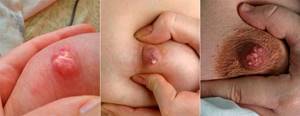
Doctors note that white pus on the nipple is not always a purulent secretion, but only has a consistency similar to it. Therefore, it is necessary to pay attention to the following points.
Pregnancy
From about the second half of pregnancy, colostrum is produced in the mammary glands. Droplets of colostrum fluid may spontaneously be released from the nipples and dry on their surface. They have a transparent yellow tint and a thick structure, and flow out absolutely painlessly.
Breast-feeding
The appearance of milk from the nipples between feedings of the baby is considered normal, so there is no reason for alarm. Occasional discharge outside of lactation of a small amount of colorless or yellow secretion without any odor is normal.
Galactorrhea
After the final completion of breastfeeding, the female breast continues to produce milk for some time. Therefore, periodic protrusion of particles of milk fluid from the nipples is noticed for 6-12 months, and sometimes this phenomenon lasts up to two years, which is not an abnormal sign.
However, if a woman stopped feeding her child for a long time or did not breastfeed at all, then doctors talk about the manifestation of galactorrhea against the background of an increased prolactin level (responsible for lactation).
Hormonal imbalance in the female body can manifest itself against the background of:
- abortion;
- reception OK;
- miscarriage;
- gynecological diseases;
- diseases of the adrenal glands and liver.
Ectasia of milk ducts
Pathology develops in patients over 45 years of age. With this disease, a liquid secretion is formed in the structure of the glands, which is not capable of resorption. Over time, the exudate emanates out through the nipples spontaneously or when pressing on the area around the nipple.
Physiological reasons
Pregnancy
During pregnancy, the hormonal profile of the female body undergoes significant changes. At different stages of fetal development, the body increases or, on the contrary, reduces the intensity of the production of certain hormones (estrogen, oxytocin, prolactin) depending on the goals that are important for a specific period of pregnancy: relaxation of the walls of the uterus and a decrease in its tone, increasing skin sensitivity, reducing a woman’s nervous excitability , swelling and preparation of the mammary glands for the process of breastfeeding.
The hormone prolactin, produced during pregnancy, promotes the release of colostrum.
At the initial stage, colostrum is a clear liquid, which becomes whiter and thicker as labor approaches. Periodically released on the surface of the nipple, the liquid dries and turns into a yellowish crust, easily washed off with water or a damp cloth.
Increased secretion of the mammary glands in the first half of pregnancy, as well as the release of fluid of a color other than cloudy white, is a reason for an early consultation with an obstetrician-gynecologist or mammologist.
Breast-feeding
The milk released during breastfeeding can dry out on the surface of the nipple, forming white-yellow crusts. In addition, during the feeding process, the child often “grabs” the mother’s papilla too tightly , as a result of which cracks form, which also become crusty. If “milky” crusts are easily removed with water or a damp cloth, then getting rid of crusts that have appeared on top of cracks causes severe pain. In this case, it is recommended to lubricate the nipples generously with a neutral moisturizing cream (Panthenol, Children's) and after a while wipe the surface of the nipple with a soft cloth or napkin.

Mechanical impact
Often the cause of injury to the nipple is prolonged mechanical impact (friction). Physical activity accompanied by a large number of movements: running, as well as increased sexual activity, can lead to rubbing of the surface of the nipples and subsequent release of fluid, which over time transforms into crusts. In addition, the mechanical impact may increase when wearing a bra or other clothing made of excessively dense and coarse fabrics.
Norm or pathology
Small amounts of clear nipple discharge may be normal. This can happen, for example, due to an impact or a fall.
It happens that before menstruation 1-2 drops of clear secretion are released, there is no cause for concern in this case. If this happens regularly, then this indicates a hormonal imbalance in the body and is a reason for medical consultation. Also, a few drops of clear liquid during sexual arousal, especially during orgasm or stimulation of the nipples during love play, may be the norm.
White or milky fluid discharged from the breast may indicate a pathology such as galactorrhea (an excess of the hormone prolactin in the body). If a woman is pregnant or breastfeeding, then this is the norm. When taking oral contraceptives, small amounts of milk-like discharge may also appear. This indicates that the drug selected is unsuitable for the woman. You should consult a doctor for the correct choice of contraceptives.
White discharge from the nipples may also indicate that there is a malfunction in one of the organs. This may be renal failure, liver failure, ovarian tumor, hypothyroidism or a mass in the pituitary gland. Purulent or green fluid indicates a breast infection. Yellow or brownish liquid may appear with mastopathy. Pathological discharge from the breast should be a reason for immediate contact with a mammologist. If the secreted fluid appeared once or twice and stopped, this does not mean that everything went away on its own, it may indicate that the pathology has become latent.
Causes of pathology
The causes of pathological discharge from the mammary glands can be inflammatory and tumor processes, hormonal imbalance in the body, and diseases of the pelvic organs. Hormonal disorders occur as a result of the use of certain medications, oral contraceptives, frequent abortions, and diseases of the endocrine system.
Video: Causes of nipple discharge in women
Diseases that cause nipple discharge
Unusual discharge may appear due to the following diseases:
- Mastitis is inflammation of the breast tissue. The inflammatory process occurs as a result of bacterial infection entering the gland. This can happen during breastfeeding if cracks form on the nipples, as well as with galactorrhea (lactation not associated with breastfeeding).
- Intraductal papilloma. With this disease, growths form inside the milk duct, which are easily damaged when pressure is applied to the corresponding area of the breast. At the same time, bloody fluid is released from the nipples.
- Ectasia (dilation) of the milk ducts. This condition is not always a pathology. It occurs, for example, when breasts swell during pregnancy or before menstruation. However, in some cases the process is irreversible. Stretching of the walls of the thoracic ducts leads to the formation of cysts filled with fluid, as well as papillomas. Usually, irreversible enlargement is the result of hormonal changes that occur in the body of women after 40-45 years.
- Mastopathy. There are different varieties of this disease. All of them are associated with the proliferation of gland tissue. The main symptoms of this pathology are nagging pain in the chest and the appearance of fluid from the nipples, which has a different color and consistency.
- Galactorrhea. The disease is expressed in the fact that when pressure is applied, milk appears from the nipple, and the process has nothing to do with breastfeeding. The main causes of the disease are hormonal disorders and increased levels of prolactin in the blood. Galactorrhea can occur with diseases of the thyroid gland and pituitary gland.
- Breast cancer. When discharge from the mammary glands appears, a woman notices asymmetry of the nipples, an enlargement of one of the glands, deformation of the skin, the appearance of compactions and other signs that require urgent diagnosis and treatment.

Unidox for acne
Ovarian inflammation symptoms
Liquid of different colors and consistency may be a concomitant sign of diseases of the pelvic organs caused by microflora disorders (thrush, intestinal dysbiosis). Discharge from the nipples occurs with ovarian diseases (chronic inflammation, polycystic disease, malignant tumor). After injuries, inflammatory processes occur in the chest, which lead to the appearance of purulent discharge from the nipple.
What causes discharge?
Women's breasts contain milk ducts, which are located between fibrous and fatty tissue. Each canal has an opening at the top of the nipple. All women have an individual number of ducts, but the maximum number can reach up to fifteen. Through the milk ducts, not only milk and colostrum are produced, but also physiological secretion.
In the absence of diseases or the influence of external negative factors, the following condition is inherent in whitish, transparent discharge from the mammary glands:
- scanty and abundant;
- thick and watery;
- viscous or slimy.
Any uniform consistency of secretion from the canals is normal, but only against the background of a transparent shade of liquid and a small volume. If there is too much discharge, it is not recommended to postpone a visit to the mammologist.
For a certain condition, there are indicators of the norm of physiological secretion:
- Scanty, thick (one or two drops). It is noted when pressing on the chest in young girls and nulliparous women a few days before menstruation and during increased sexual arousal.
- Not very abundant, liquid. Characteristic of older women and women who have given birth, but the appearance of thick liquid is possible.
- Viscous. Colostrum occurs during gestation, breastfeeding, and for several years after cessation of lactation (individual indicator).
When nipple discharge is normal
The norm is the appearance of colostrum in the breast during pregnancy (transparent yellowish discharge that occurs when pressure is applied to the nipple). Colostrum sometimes appears even in the very early stages of pregnancy, when the woman is not yet aware of its onset.
After childbirth, milk is produced in the breast. Lactation continues throughout the entire feeding period and for some time after its end. Milk production stops gradually. If its release from the glands occurs when pressing on the nipple for several months (and even 2-3 years) after breastfeeding is completed, this is also normal.
Often milk appears after an abortion or miscarriage. This is explained by the natural hormonal changes that occur in the condition of the breast during pregnancy. After the hormonal levels are normalized, the discharge disappears.
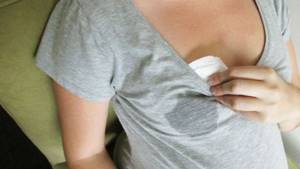
Addition: Sometimes scanty transparent discharge appears in women on the eve of menstruation when pressing on the nipple. These may be normal hormonal changes characteristic of this phase of the cycle, and various diseases. It is necessary to visit a mammologist to make sure there are no pathologies.
The appearance of clear liquid when pressing on the nipple also occurs in women taking hormonal medications or antidepressants. Sometimes discharge appears due to irritation of the nipples by a tight bra or during physical activity associated with chest tension.
Normal discharge is clear or milky white and odorless. If discharge appears mixed with blood, pus, with any color or unpleasant odor, this indicates the presence of pathology. In addition, such discharge is often accompanied by changes in the condition of the breasts and a deterioration in the woman’s well-being.
What could it be?
The first alarming symptom that indicates a possible disease is discharge from the mammary gland, which occurs when pressed and independently.
The causes of discharge are:
- Physiological: at birth - engorgement of the glands with the release of colostrum, the period of pregnancy and lactation, when the gland produces milk, residual discharge after the end of feeding.
- Pathological—hormonal disorders in the body, age-related changes, inflammatory diseases of the mammary glands, tumors.
Additional symptoms of the pathological condition

Pus on the nipples does not just appear; it always indicates some abnormal processes in the glands. Typically, this pathological condition is accompanied by other clinical symptoms that cause the woman considerable discomfort:
- Swelling of the breast.
- A feeling of fullness in the area of the problematic breast.
- The manifestation of pain, the severity of which depends on the severity of the pathology.
- Temperature rises to high levels.
- Itching or burning of the breasts and nipples.
- Redness of the skin of the chest.
- Breast engorgement and the appearance of characteristic lumps in its structure.
- Hyperemia (overflow of the blood vessels of the breast).
In the presence of a malignant tumor in the mammary gland or Paget's syndrome (nipple cancer), the above-described symptoms are supplemented by other signs:
- Bloody pus from the nipples, discharged spontaneously.
- A significant increase in the volume of the gland in which the tumor is present.
- Purulent secretion flows from only one breast.
- Marked darkening of the areolar region.
- Nipple retraction is observed.
- A “lemon peel” forms on the skin of the chest.
- Peeling of the skin on the areola and nipple.
The pus that is present does not always drain spontaneously - sometimes it appears from the nipples only when pressed. Exudate can flow freely only if there is a significant accumulation of it.
Pathological discharge
An unpleasant smell of discharge and a color different from transparent will most often occur with pathology. It is worth conducting regular breast self-examination in order to be prepared for possible violations. Let us list the main types and characteristics of breast secretions.
Ectasia (dilation) of the gland ducts
The Milky Ways expand under the influence of thick secretions, which can have different colors, even green and black. If such blockage of the ducts is not accompanied by their inflammation, then nothing bothers the woman except a strange discharge.
The disease can only be treated surgically; taking anti-inflammatory drugs and warm compresses only temporarily improves the condition.
Chest injury
If the mammary gland has been injured without compromising the integrity of the skin (by an exercise machine, steering wheel, in a crowd), then within 48 hours a bloody fluid may be discharged from the nipple. In addition, there will be pain at the site of injury.
Papilloma inside the milk duct
This is the name of a benign tumor, similar to those found on the skin. Moreover, it develops not under the influence of the papilloma virus, but for unknown reasons.
This tumor appears in the duct near the nipple, manifesting itself as thick discharge of different colors, sometimes mixed with blood. Discharge usually appears when the nipple is stimulated. Treatment of pathology is surgery.
Abscess and mastitis
An abscess is an accumulation of pus limited by a capsule in the mammary gland, while mastitis is an inflammation of an area of the gland that does not have clear boundaries. Both of these pathologies usually occur either during lactation, or as a result of penetrating injury to the gland by an infected object.
Both diseases are accompanied by discharge of pus from the nipple, which has a yellow or green color and an unpleasant odor, as well as fever, pain in the mammary gland, a lump that can be detected by touch (with an abscess it will be delimited), which will be very painful and hot.
Both pathologies are treated with antibiotics, which is carried out simultaneously with the opening and drainage of purulent cavities.
Galactorrhea
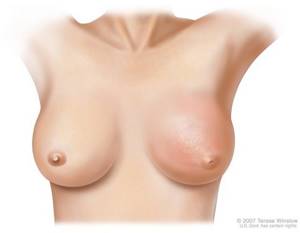
This term refers to the secretion of milk from the mammary glands of a nulliparous and non-pregnant woman. The reason for this condition is an increase in the level of the hormone prolactin due to one of the reasons:
- frequent nipple stimulation;
- pituitary tumor consisting of prolactin-synthesizing cells;
- reducing the inhibitory effect of the thyroid gland;
- taking contraceptives.
For diagnostic purposes, a determination of thyroid hormones in the blood is performed, as well as a magnetic resonance and x-ray examination of the cranial cavity to determine the existence of a pituitary tumor. Treatment is prescribed depending on the data obtained as a result of the examination.
Fibrocystic mastopathy
This is a condition considered dangerous in terms of degeneration into cancer, characterized by the appearance of small cysts and areas of tissue resembling scar tissue in the breast. Typically, mastopathy is manifested not only by discharge from the nipple, which can be greenish or black, but also by pain and swelling of the mammary glands before and during menstruation. In the period after menstruation, nothing bothers the woman; her general condition is not disturbed.
Treatment of this pathology is conservative. Read more in the publication about fibrocystic mastopathy.
Breast cancer
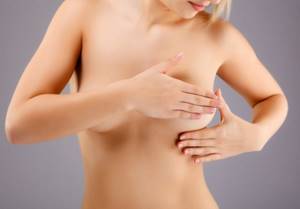
With this life-threatening pathology, discharge from the nipples of a different nature may appear: transparent, yellow, bloody. If a woman notices such discharge from only one gland, her condition has not changed, but there are also:
- nipple retraction;
- painless lump in the chest;
- enlargement and density of lymph nodes in the same or opposite armpit;
- breast deformation.
You need to urgently undergo a mammogram and, without delaying a minute, contact an oncologist-mammologist.
Paget's disease
This is the name of a malignant tumor of the nipple or areola. It manifests itself:
- bloody discharge from the nipple;
- peeling of the nipple and areola;
- redness in the nipple area;
- itching or burning of the areolar area;
- nipple retraction.
This disease is very malignant and requires prompt diagnosis followed by radiation and surgical treatment. Read more about it in our other publication.
How dangerous is purulent nipple discharge?
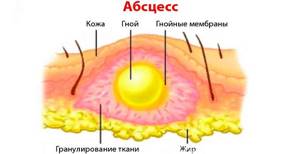
Lack of timely treatment of the root cause of purulent secretion leads to aggravation of the pathological process in the mammary glands and the manifestation of severe complications:
- The disease develops into a chronic form.
- Spillage of pus into adjacent chest muscles.
- Development of abscess of the second and subsequent stages.
- Infectious-toxic shock.
- Manifestation of phlegmon.
- Formation of a fistula tract.
- Sepsis (necrotic exudate enters the lymphatic fluid and blood, and spreads throughout the body).
If purulent discharge from the nipple is accompanied by additional severe symptoms, and the woman’s well-being is worsening every day, you should not self-medicate or puncture the abscess in an attempt to remove the purulent accumulation. Illiterate actions will only worsen the clinical picture and can lead to disastrous consequences.
Is it possible to continue breastfeeding when pus appears?
If a nursing woman develops pus from her nipple when she presses, can she continue breastfeeding? The degree of probability of maintaining lactation depends on the root cause and stage of advanced disease. Therefore, this issue must be resolved with a pediatrician and mammologist or gynecologist, based on the individual characteristics of the pathological situation.
| Nature of the condition | Peculiarities |
| For mild illness | There is every chance of maintaining breastfeeding. |
| In case of severe manifestation | A woman may be prescribed medications that suppress the lactation process, antibiotics and other potent drugs. However, this category of drugs is prescribed for a short period (up to three days), so after their discontinuation, lactation can be restored. |
If during treatment a decision was made to interrupt breastfeeding, then after recovery you can return to natural feeding by frequently applying the baby to the breast. In addition, women are advised to take teas and products that improve breast milk production.
Other features for preserving humid waste:
- If you have lactation mastitis with nipple purulent discharge in small quantities, you can feed your baby with the problem breast, but only after consulting a doctor.
- It is necessary to regularly express milk from the sore breast.
- You can breastfeed with healthy breasts without restrictions, provided that the mother is prescribed antibiotics and other medications that are compatible with breastfeeding.
- If there is an abundant presence of pus in the milk, then breastfeeding should not be done. In this case, you need to express the milk from the infected gland and pour it out. You need to express it until the pus stops coming out.
- In severe cases of lactation mastitis with relapses, when the patient has undergone surgery, drug interruption of lactation is indicated. Traditional suspension of milk secretion (tight bandaging of the breast, etc.) is contraindicated.
- Elimination of purulent abscesses (abscesses, boils, etc.) is carried out exclusively in hospital settings. Today, low-traumatic surgical methods of treatment are used, for example puncture (pulling out purulent contents with a special needle). If all medical recommendations are followed during the post-procedure period, a young mother can maintain lactation.
When there is cause for concern
If white dots appear on your nipples, and the process is accompanied by itching, burning and pain, you should rush to see a doctor. Such symptoms indicate the development of a dangerous pathological process.
Fox-Fordyce disease
A chronic skin disease consisting of proliferation of the ducts of the sebaceous glands and blockage of the sweat glands. Usually occurs against the background of endocrine and metabolic disorders, but the underlying cause is unknown. Pathology appears mainly in young women. Fordyce granules form around the nipples in the area of the hair follicles. Due to the nature of the skin secretion, the rashes are very itchy. Itching worsens before menstruation. The disease may subside spontaneously. This usually occurs during pregnancy in the 3rd trimester. To eliminate physical discomfort, antihistamines and sedatives are prescribed. If endocrine disorders are detected, it is necessary to take hormonal medications. The production of skin secretions is suppressed using radiation therapy. If all else fails, skin grafting, curettage of the glands, or cauterization with a laser are performed.
Lactostasis
White spots on the nipples themselves may be a sign of blockage of the milk ducts due to stagnation of milk. This happens due to compression of the breast by a tight bra, incomplete emptying of the gland, dehydration, hypothermia or mechanical injury. The ducts become clogged with milk plugs, which are visible on the surface of the nipple. There is pain in the chest, especially after feeding. Its surface becomes covered with red spots, and seals can be felt underneath them. Sometimes signs of intoxication appear: fever, chills, weakness.
Non-drug treatment is aimed at eliminating stagnation. It is necessary to wear underwear that is the right size, position the baby correctly at the breast, and feed the baby more often. Before feeding, to facilitate the outflow of milk, heat should be applied to the breast, and then cold should be applied to relieve swelling and reduce inflammation. Self-massage is useful. If milk remains after feeding, it must be expressed. If the temperature rises above 38 degrees, you should immediately contact a gynecologist or mammologist. This symptom is a sign of inflammation. Lactostasis that persists for more than 2 days leads to mastitis. Mastitis, in turn, can cause cancer.
If there are no subjective sensations, there is no need to be afraid of white spots on the nipples and areola. But if physical discomfort occurs, medical attention is necessary.
Features of diagnostics
If a woman discovers pus from the nipple of the mammary glands, she should immediately contact a mammologist. A particularly urgent visit to the doctor’s office is required in the following cases:
- Discharge of purulent secretion with blood.
- The flow of pus is profuse and does not stop.
Experts warn against self-medication, which often only aggravates the course of the disease and provokes the development of severe complications.
After examining the mammary glands, the doctor will prescribe a diagnostic test to clarify the root cause of the pathological phenomenon:
- X-ray of the breast.
- Ultrasound.
- Ductography.
- Mammography.
- Needle biopsy.
You will also need to pass laboratory tests:
- General blood test.
- Hormone analysis.
- Test for tumor markers.
- Cytological test of pus.
Based on the examination data obtained, a diagnosis is established and a treatment regimen is developed.
Discharge during pregnancy
Immediately after conception, a woman’s body changes - the level of sex hormones increases, the breasts increase, and a venous network appears. A yellowish or white substance begins to ooze from the nipples - colostrum, which precedes milk production. The phenomenon is observed more often before childbirth, but can occur as early as 20-23 weeks of pregnancy. The glandular tissue grows, and prolactin provokes the appearance of milk to feed the baby.
If intense discharge is accompanied by unpleasant symptoms, you should consult a gynecologist:
- regular aching chest pain;
- bloody fluid from the nipples;
- the mammary glands enlarged unevenly, pronounced swelling appeared;
- there are bumps or depressions.
Many symptoms will be helped by removing comfortable underwear that does not constrict the chest and there is no feeling of pressure.
What treatment is indicated for the presence of pus?
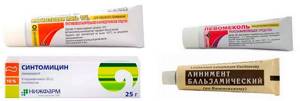
Doctors advise against self-treatment, especially if the symptomatic manifestations are severe. First of all, it is necessary to identify the nature of the disease that led to the formation of pus, and only then decide on therapy.
However, there are situations when it is not possible to visit a doctor’s office in the next few hours. In this case, you can use external medications to alleviate the condition.
How to remove pus from a nipple at home? The following medications help:
- Vishnevsky ointment.
- Levomekol.
- Ichthyol ointment.
- Solcoseryl.
- Bepanten.
- Panthenol.
- Baneocin.
Even after successful use of external remedies, you should consult a doctor at the first opportunity.
Treatment against diseases
Features of therapy depend on what pathological processes cause the appearance of purulent secretion from the nipples:
- Inflammation. For mastitis, anti-inflammatory and antiseptic drugs are prescribed, and in severe situations, surgical intervention is used.
- Bacterial infections. Treatment with antibiotics and, in some cases, hormonal agents is recommended.
- Intraductal papilloma. It can be cured surgically (excision of the affected area of the breast is performed).
- Surgery. It is performed in situations where it is necessary to open a boil or remove a tumor in the breast tissue.
- Malignant tumors, including Paget's disease. A mastectomy of both glands is prescribed or only one formation is removed.
Use of medications
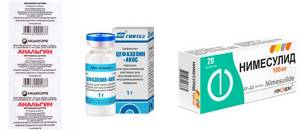
| Drugs | Drug effect | Name |
| Nonsteroidal anti-inflammatory drugs | Reduce pain. Relieves swelling. Suppress the inflammatory process. | Nimesulide. Diclofenac. Indomethacin. |
| Analgesics | Relieves pain. | Analgin. Tempalgin. Paracetamol. |
| Antibiotics | Inhibits the activity of pathogenic organisms. | Amikacin. Cefazolin. Isepamycin. Tobramycin. Cephalexin. Kanamycin. |
The appearance of purulent discharge from the nipple is an alarming symptom that is characteristic of many serious diseases. If a woman detects pus discharge, she should immediately consult a doctor.
Pregnant and nursing mothers should be especially careful about their mammary glands. The sooner the cause of the pathological condition is identified and appropriate treatment is carried out, the fewer negative consequences for the body will be in the future.
Treatment
Help before diagnosis
The periodic occurrence of colostrum-like discharge from the nipples in pregnant women is normal and does not require specific therapy. Women need to regularly visit the gynecologist and promptly inform the doctor if the amount or color of the discharge has changed. White discharge from the breasts in non-pregnant patients indicates the presence of the disease, so they should seek medical help. It is not advisable to take medications until the cause of the symptom is determined.
Conservative therapy
Medical tactics depend on the underlying disease that caused colostrum-like discharge. If the symptom is caused by taking certain medications, the treatment regimen is adjusted and, if possible, these drugs are replaced with drugs with a similar pharmacological effect. It is necessary to stop taking plants that stimulate lactation. Drug therapy includes several groups of drugs:
- Dopamine agonists
. The drugs directly affect the cause of nipple discharge: they increase the level of the neurotransmitter dopamine in the brain tissue, thus reducing the amount of prolactin. Medicines are used as initial therapy, especially in women who want to become pregnant. - Hormonal drugs
. For diseases of the reproductive system, estrogen preparations, which suppress lactation, are used to reduce colostrum-like secretions. For pathologies of peripheral endocrine organs, hormone replacement therapy with drugs containing thyroxine and cortisol is effective.
Surgery
Surgery after initial therapy aimed at reducing tumor size is indicated for all hypothalamic-pituitary neoplasias that stimulate the appearance of colostrum-like discharge. Surgical removal of the adenoma is combined with targeted radiation therapy. Surgeries are recommended for extensive lesions of the ovaries (polycystic disease, large dermoid cysts) and uterus (diffuse endometriosis). Depending on the patient’s age and her reproductive plans, organ-preserving or radical interventions (oophorectomy, hysterectomy) are performed.

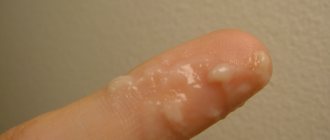



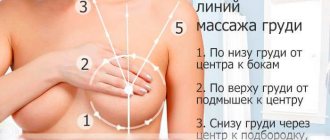




![[Photo review] “A Sassy Nation” bodysuit from Black Milk Clothing](https://superlady555.ru/wp-content/uploads/fotoobzor-bodi-a-sassy-nation-ot-black-milk-clothing-330x140.jpg)
